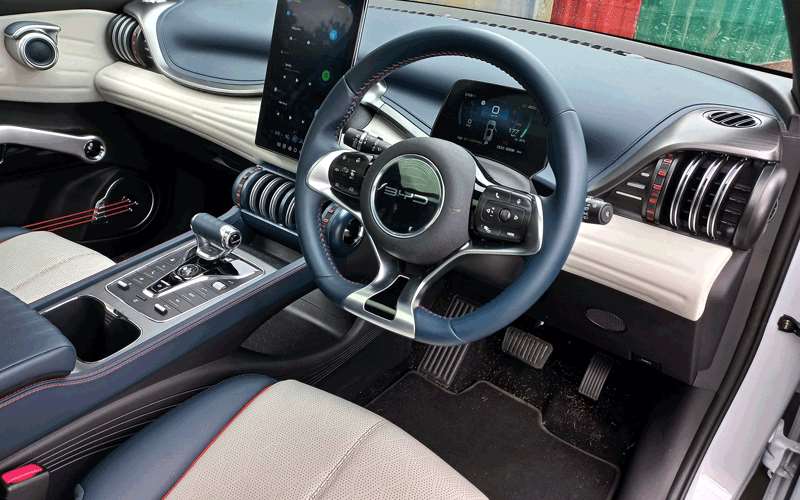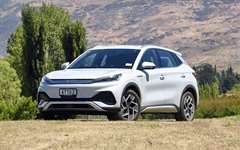The BYD Atto 3 has been named the 2022 New Zealand Car of the Year, becoming the fourth all-electric vehicle to scoop New Zealand’s premier motoring award in as many years.
The Atto 3 also becomes the first vehicle from a Chinese brand to secure national Car of the Year honours, underscoring China’s emergence as a powerhouse maker of electric cars, most for everyday motorists.
In announcing the fully electric compact five-seater as 35th winner of its annual award, New Zealand Motoring Writers Guild president Richard Bosselman noted the Atto 3’s trophy success was a significant achievement for BYD internationally as well as in New Zealand.
‘‘We are a small market but we are one of BYD’s first export destinations. Plus the Atto 3, their first car here, has been on sale for under a year, so securing the most sought-after motoring prize is a huge coup.
‘‘Atto 3 has won various car of the year category awards around the world, but actually winning an overall national car of the year title seems to be a world-first for BYD,’’ he said.
‘‘Adoption of ‘new-energy vehicles’ is a domestic priority, and an increasing count of Chinese makers are building, and exporting such cars.
‘‘BYD has been a particularly fast mover and has reaped spectacular reward.’’

BYD national brand manager Warren Willmot accepts the New Zealand Car of the Year trophy.
While having an all-electric car win the Car of the Year award is nothing new now, the Atto 3 differs markedly from previous battery-powered winners in respect of affordability.
Once Government rebates are factored in, the standard-range Atto 3 costs a shade over $50,000, while the extended range flagship variant is just $4000 more.
By contrast, last year’s Car of the Year winner — the Hyundai Ioniq 5 is a $70,000 machine even in base-model form, while previous all-electric winners from Mercedes and Jaguar carry six-figure price tags.
Dollar-for-dollar, the Atto 3 is an impressive car. It combines contemporary exterior styling with a boldly-rendered and very modern interior.
Build quality is very good, and the standard equipment list — including a raft of active safety features — is impressive too. Performance is lively, and handling, ride quality and refinement are on par with equivalent models from other makers.
As for battery range, the Atto 3 is rated for 345km in standard guise and 420km in extended range form under the WLTP test regime.
All those factors came into play not only for Car of the Year, but also for the four stars plus test rating awarded when Drivesouth road-tested the extended range version of the Atto 3 a few weeks back.
‘‘BYD has charged out of the blocks and hit the mark with the Atto 3. Reassuringly normal to look at, yet refreshingly daring within, it is finished to a high standard and presents both leading-edge technology and a credible real-world range at a sharp price,’’ was the verdict at the end of the test.
The Atto 3 is the first of several new models heading here from BYD, a company which was only founded in 1995. Its initial focus was making batteries for consumer electronics — it once produced half the world’s cellphone batteries — the company moved into car production in 2002. Within seven years it produced China’s best-selling car.
A key to BYD’s success has been its battery technology, known as ‘‘the blade’’ due to the long, thin shape, which uses only materials that are abundant in the earth’s crust — lithium, iron and phosphate — while avoiding controversial metals such as cobalt and nickel.
The BYD Atto 3 beat out eleven other finalists in the New Zealand Car of the Year awards, including a majority that also features battery power. These other finalists were the BMW iX; Ford Everest; Hyundai i20 N; Kia EV6 and Kia Sportage;
Lexus NX; Mercedes-AMG EQS 53 and Mercedes-Benz C-Class; Mitsubishi Outlander; Polestar 2 and Tesla Model Y.
‘‘That we elected to consider 12 finalists for the 2022 award rather than the usual top 10 says much. There is one winner, but my sentiment is there were no poor choices,’’ Mr Bosselman said.
The New Zealand Car of the Year award is open to all passenger vehicles launched over a 12-month period.
To be eligible for the award they must have been evaluated by over two-thirds of the guild’s 20 voting members, with testing undertaken over each member’s local roads, not on a track. This allows voting to be based on the same experience an owner would have, using the car in their day-to-day life, in different parts of New Zealand.
The guild members evaluated all finalists against a range of criteria including: how the vehicle performs its intended role; its styling, interior design and accommodation; fit, finish and quality; ride and refinement; performance; roadholding and handling; value for money; active and passive safety and environmental responsibility.

- David Thomson








